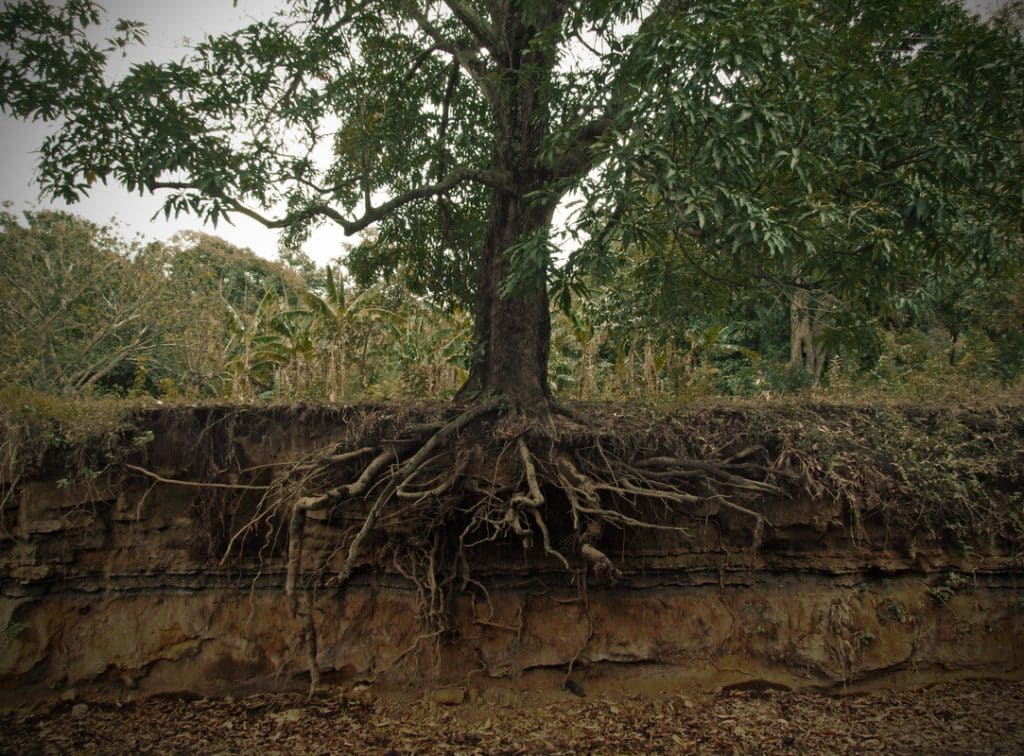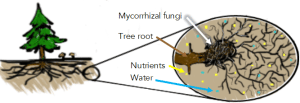
A trees life is not as easy as it may seem. Like any living organism trees are always allocating their limited resources to meet internal growth and defend against a variety of external factors. When a tree health begins to decline, it indicates the trees current growing conditions are not allowing it to meet all it’s needs, or something has overcome its defenses.
Once this downward spiral begins it is very unlikely a mature tree will recover on his own. Timely intervention, and a sustained maintenance plan, can alleviate current tree stress and reinforce against future adverse conditions. Long-term success requires consideration of all a tree’s needs and its environment.
Ideal candidates for long-term, holistic maintenance are trees such as western red cedar, Douglas fir, western hemlock, big leaf maple, and other large, stately trees.
Approximately 95% of the world’s plant species form mycorrhiza and require the association for maximum performance in the field.
Endomycorrhizae—also referred to as Vesicular Arbuscular Mycorrhizae (VAM)—symbiotically associate with about 90% of the plant kingdom. Their origins date back 350–460 million years and were important in the colonization of land by vascular plants. Endomycorrhizae form an intercellular attachment by penetrating the cell wall of plant roots and forming branched structures called arbuscules within the root cells. These arbuscules provide an extensive surface area for the exchange of nutrients through the cell membrane. Mycelia from endomycorrhizae extend from the plant roots into the surrounding soil, gathering nutrients and water bringing them back to the plant’s roots.

|
Acacia
Agapanthus Alder Almond Apple Apricot Aspen Araucaria Artichoke Ash Asparagus Avocado Bamboo Banana Barley Basil Bayberry Bean Beech Begonia Black Locust Blackberry BlueGrama BoxElder Boxwood Brazilian Rubber Bulbs,all Burning Bush Cacao CactusCamellia Carissa Carrot Cassava Ceanothus Cedar Celery |
Cherry
Chinese Tallow Chrysanthemum Citrus, all Clover Coconut Coffee CoralTree Corn Cotton Cottonwood Cowpea Crab Tree Creosote Bush Cucumber Currant Cypress Dogwood Eggplant Eucalyptus Euonymus Fern FescuesFig Flowers, almost all Forsythia Fuschia Gardenia Garlic Geranium Grapes,all Grasses, almost all Green Ash Guayule Gum |
Hemp
Herbs, all Hibiscus Holly Hops Hostas Impatiens Jojoba Juniper Kiwi Leek Lettuce Ligustrum Lily Magnolia Mahonia Mango Maples, allMarigold Mellon, all Mesquite Millet Mimosa Morning Glory Mountain Laurel Nasturtium Okra Olive Olive Palm Onion Palms, all Papaya Passion Fruit Paw Paw Peach Peanut Pecan Peppers, all Pistachio Pittosporum |
Plum
Podocarpus Poplar Poinsettia Potato Pumpkin Raspberry RedwoodRhaphiolepis Rice Rose Russian Olive Ryegrass Sagebrush Saltbush Sequoia Snapdragon Sourwood Soybean Squash Strawberry Succulents Sugar Cane Sumac Sunflower Sweet Gum Sweet Potato Sycamore Tea Tobacco Tomato Walnut Wheat Willow Yam Yew, all |
|
Alder
Arctostaphylos Aspen Basswood Beech Birch |
Chestnut
Chinquapin Cottonwood Douglas fir Eucalyptus Filbert |
Fir
Hazelnut Hickory Hemlock Larch LindenMadrone |
Manzanita
Oak Pecan Pine PoplarSpruce Willow |
 Plant Groups That Benefit From Both Endo- and Ecto-mycorrhizae
Plant Groups That Benefit From Both Endo- and Ecto-mycorrhizae|
Brassica Family
Broccoli Brussels Cabbage Cauliflower Collards Kale Rutabaga |
Ericaceae Family
Azalea Blueberry Cranberry Heath Huckleberry Lingonberries Rhododendron |
Others
Beet Carnation Mustard Orchids Protea Rush Sedge Spinach |